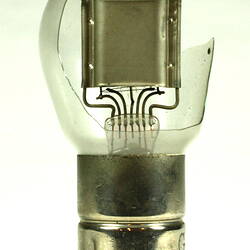Summary
Alternative Name(s): Electronic Vacuum Tube; Thermionic Electron Valve
General purpose triode electronic valve. 2.8 volt directly heated cathode. Designed for use with dry cell batteries as an electric power source.
The manufacture of BTH branded electronic valves begun during WWI at the firm's Mazda electric lamp works, which had been established at Rugby, England, in 1911. By the early 1920s they had become a major porduction line with dozens of different designs offered.
Base Europe 4-Pin (A, 4A, B4, since 1914)
Filament Vf 3 Volts / If 0.12 Ampere / Direct / Battery = /
Description Va 40 to 120.
"Made at the Mazda Lamp Works For use with Dry Cells) RFJ/BTH Advertisement
This valve is believed to have previously been used or collected by Francis West Chambers (1861-1928), who from 1909 held the position of electrical inspector for the Public Works Department of Victoria, with responsibility for supervising municipal power supply undertakings, and later held a similar role with the State Electricity Commission of Victoria from 1921. During the early 1900s he had collaborated with Henry Walter Jenvey in the first experimental wireless telegraphy experiments in Australia.
Physical Description
Conical bulb with 4 pin European style base with metal shell. Bulb is sectioned so that fragment with type number is no longer there.
More Information
-
Collection Names
-
Collecting Areas
-
Acquisition Information
Donation from Mr E. W. Chambers, 10 Jun 1948
-
Manufacturer
The British Thomson-Houston Co. Ltd (BTH), Rugby, Warwickshire, England, Great Britain, circa 1925
-
Past Owner (Probable)
Mr Francis W. Chambers, Mount Eagle, Heidelberg, Greater Melbourne, Victoria, Australia, circa 1925-1928
-
Inscriptions
Bulb: BBC/Made in England Base: BT-H
-
Brand Names
-
Classification
-
Category
-
Discipline
-
Type of item
-
Overall Dimensions
112 mm (Length), 51 mm (Outside Diameter)
-
Keywords









